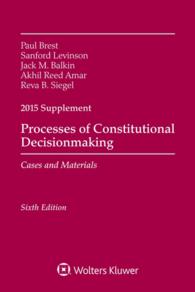Full Description
Since the introduction of coronary angiography, a key technique in understanding coronary artery disease, a number of paradigms regarding its study and interpretation have taken place. Following an emphasis on improved angiographic and subsequent intracoronary imaging techniques, functional assessment of coronary circulation has demonstrated to have major implications for diagnosis and treatment of coronary artery disease. Fractional flow reserve, a pressure derived index of stenosis severity, constitutes the best example of the current importance of physiological assessment in clinical practice. However, the acceptance of FFR by cardiologists contrasts with important voids in knowledge on the basic principles of coronary physiology and of other available techniques that, as an alternative to FFR, allow a more comprehensive assessment of coronary circulation. This is particularly noticeable in the assessment of microcirculation, an unavoidable compartment of coronary circulation that is frequently affected in acute coronary syndromes of in the presence of cardiovascular risk factors or non-coronary heart disease. A deeper understanding of the relationship between epicardial vessel and microcirculatory involvement has started with the advent of newer imaging techniques like invasive optical coherence tomography, and non-invasive CT and NMR techniques. This book aims to be an indispensable tool for clinicians and researches in the field of coronary artery disease. It provides a balanced, comprehensive review of anatomy, physiology and available techniques, discusses both the diagnosis of epicardial vessel and microcirculatory disease, the impact of different diseases at different levels of coronary circulation, and the best way to address a separate or combined assessment of different levels of coronary circulation.
Contents
FOREWORD.- INTRODUCTION.- Part 1. The Coronary Circulation in Health and Disease.- STRUCTURE AND PHYSIOLOGY OF THE CORONARY CIRCULATION.- A historical perspective on coronary circulation.- The anatomy of epicardial ,coronary arteries and veins.- The structure of transmural vessels and coronary microcirculation.- Regulation of coronary blood flow.- Myocardial metabolism and blood supply.- Coronary capacitance and the myocardial pump model.- Extravascular compression and vascular waterfalls.- Extrinsic neural control of blood flow.- Hemodynamic effects of epicardial stenoses.- Modification of shear stress by stenoses.- Phasic characteristics in coronary blood flow.- PATHOLOGICAL CHANGES IN CORONARY CIRCULATION.- Epicardial coronary stenosis.- Microvascular remodelling.- Microvascular obstruction.- Extravascular compression of the microcirculation.- Endothelial dysfunction.- Collateral development.- EFFECT OF SPECIFIC PATHOLOGIES ON EPICARDIAL VESSELS AND THE MICROCIRCULATION.- Hypertension and left ventricular hypertrophy.- Diabetes.- Dyslipidemia.- Atherosclerosis. Acute coronary syndromes.- Atherosclerosis. Chronic ischemia.- Acute and chronic effects of percutaneous coronary interventions.- Valvular heart disease.- Part II. Invasive Assessment of the Coronary Circulation in the Catheterization Laboratory.- FRACTIONAL FLOW RESERVE (FFR).- Understanding fractional flow reserve.- Current evidence on FFR as a clinical tool.- Application of fractional flow reserve to specific stenosis subsets.- INSTANTANEOUS WAVE FREE RATIO (iFR).- Physiological principles of iFR.- Validation of iFR. Clinical registries.- Application of iFR in clinical scenarios.- CORONARY FLOW RESERVE.- Understanding coronary flow reserve.- Use of Doppler-tipped guidewires to calculate coronary flow reserve.- Relative and adjusted coronary flow reserve.- Use of the thermodilution principle to calculate coronary flow reserve.- INDICES OF CORONARY RESISTANCE.- Understanding indices of coronary resistance.- Stenosis resistance estimated from pressure-flow relationships.- Myocardial resistance estimated with thermodilution and pressure.- Microcirculatory resistance calculated from intracoronary pressure and Doppler.- Integration of pressure and flow indices of coronary stenosis severity.- WAVE INTENSITY ANALYSIS.- Understanding wave intensity analysis.- Wave patterns in coronary flow in health and disease.- Changes in WIA coronary patterns during trans-arterial valve implantation.- ASSESSMENT OF ENDOTHELIAL DYSFUNCTION.- Understanding endothelial modulation of vascular tone.- Assessment of endothelial dysfunction with acetylcholine challenge.- Other methods to assess endothelial dysfunction.- RESEARCH MODELS.- Relevant differences between coronary circulation in human and experimental animal models.- Computerised fluid dynamics applied to modelling of coronary circulation.





